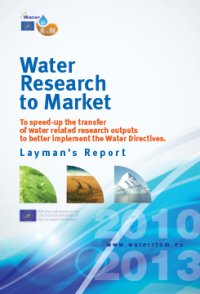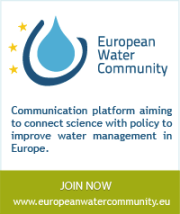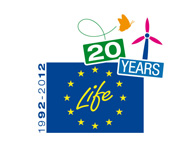Clean Water
| Output characterisation | |
| OUTPUT SENTENCE | Clean Water: Water detoxification using innovative vi-nanocatalysts |
| OUTPUT TYPE | prototype |
| WATER TOPIC | Consumption |
| KEYWORDS | drinking water, nanofiltration |
| MARKET NEED TAILORED | Water Frame Directive |
| OUTPUT DESCRIPTION | Innovative nanostructured photocatalysts and corresponding continuous flow photocatalytic-disinfection-membrane reactors for sustainable and cost effective water treatment and detoxification can be developed by using doped TiO2 nanomaterials with visible light response. The new technology exploits solar energy, recent advances in nano-engineered titania photocatalysts and nanofiltration membranes for the destruction of extremely hazardous compounds in water. To this aim, the UV-vis responding titania nanostructured photocatalysts can be stabilized on nanotubular membranes of controlled pore size and retention efficiency as well as on carbon nanotubes to achieve photocatalytically active nanofiltration membranes. Specific target pollutants including cyanobacterial toxin MC-LR and endocrine disrupting compounds (EDC) in water supplies as well as classical water pollutants such us phenols, pesticides and azo-dyes can be efficiently decomposed. The scale up of the photocatalytic technology and its application in tanks and tap water for public use and consumption is ongoing. |
| STATE OF DEVELOPMENT | Program has been finished |
| INNOVATIVE ASPECTS AND ADVANTAGES | energy recovery system protection not only from chemicals but also from bacterial toxines |
| INTELLECTUAL/INDUSTRIAL PROPERTY RIGHTS | Dr. Polycarpos Falaras, Project Coordinator Research Director, Director of the Institute of Physical Chemistry NCSR Demokritos, |
| TRANSFERABILITY | Transferable |
| POTENTIAL USERS/CLIENTS | Private companies, labs, researchers, general everyday user interested in water detoxification using innovative vi-nanocatalysts |
| Estimation of risks | |
| INNOVATIVE DISADVANTAGE | output is weekly advertised results of data are not avaiable on a web page |
| EVALUATION OF RISKS FOR OUTPUT USERS | Needs firhter distribution and advertisment |
| ECONOMICAL RISKS | Personal costs (salary, trainings for employees) |
| TECHNICAL RISKS | Organisation of trainings for prospective end-users |
| MARKET RISKS | Advertisment of the output |
| Steps ahead | |
| NEXT STEPS TO ACHIEVE THE STATUS 'READY TO USE' | dissemination pilot tests |
| INVOLVEMENT OF THE OWNER FOR THE NEXT STEPS | - |
| TYPE OF PARTNER FOR THE NEXT DEVELOPMENTS | SME/Company, research organisations |
| TASKS TO BE PERFORMED | dissemination pilot tests |
| COLLABORATION DETAILS | Assistance, financing and dissemination |
| Estimation of ressources | |
| RESOURCES FOR NEXT STEPS | Time, financial resources |
| FORESEEN COSTS FOR NEXT STEPS | costs form advertisement |
| Contact | |
| TECHNICAL CONTACT | Dr. Polycarpos Falaras, Project Coordinator |
| COUNTRY | GREECE |
| WEBSITE | http://www.photocleanwater.eu/ |
| WATER RTOM CONTACT | Gdansk Water Foundation |
| Background | |
| PROJECT NAME | Clean Water |
| PROJECT ACRONYM | CLEANWATER |
| PROJECT DESCRIPTION | Innovative nanostructured photocatalysts and corresponding continuous flow photocatalytic-disinfection-membrane reactors for sustainable and cost effective water treatment and detoxification can be developed by using doped TiO2 nanomaterials with visible light response. The new technology exploits solar energy, recent advances in nano-engineered titania photocatalysts and nanofiltration membranes for the destruction of extremely hazardous compounds in water. To this aim, the UV-vis responding titania nanostructured photocatalysts can be stabilized on nanotubular membranes of controlled pore size and retention efficiency as well as on carbon nanotubes to achieve photocatalytically active nanofiltration membranes. Specific target pollutants including cyanobacterial toxin MC-LR and endocrine disrupting compounds (EDC) in water supplies as well as classical water pollutants such us phenols, pesticides and azo-dyes can be efficiently decomposed. The scale up of the photocatalytic technology and its application in tanks and tap water for public use and consumption is ongoing. |
| LEADER | Dr. Polycarpos Falaras, Project Coordinator Research Director, Director of the Institute of Physical Chemistry NCSR Demokritos, Institute of Physical Chemistry 153 10 Aghia Paraskevi Attikis, Greece Tel: +30-210-6503644 , Fax: +30-210-6511766 E-mail: papi@chem.demokritos.gr |
| COUNTRIES INVOLVED | GR, IT, UK, SP, POR, FR, USA |
| FUNDING ORGANISATION | CleanWater is a Collaborative Project co-funded by the Research DG of the European Commission within the joint RTD activities of the Environment and NMP Thematic Priorities |




